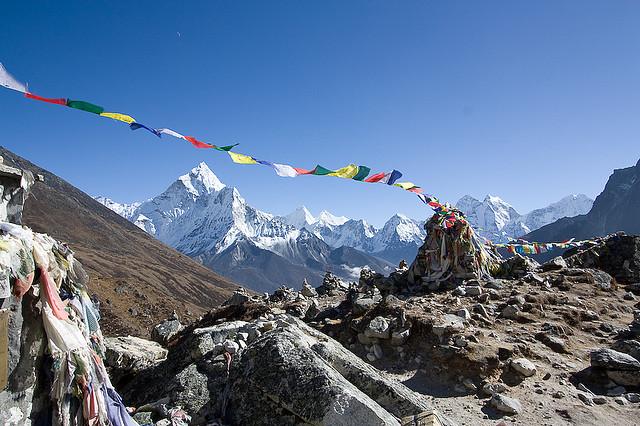
Dispelling the idea that the earthquake-ravaged country of Nepal is a chaotic pile of rubble – without hiding the very real devastation – is no mean feat for a poor nation where half a million people rely on international tourists for their livelihood.
The magnitude 7.8 Gorkha quake shook the south Asian nation to its core on April 25 this year and its aftershocks numbered in the hundreds.
It claimed the lives of 9000 people, injured more than 22,000 and, as ancient temples and shrines tumbled, the world watched in real time via social media posts from trekkers and travellers on the ground.
Angela Macdonald-Smith, an Australian journalist, was one of those. She had just finished a two-week trek around Mount Manaslu, near the epicentre of the quake, and was sipping her first coffee for a fortnight at a low, rooftop cafe in Kathmandu.
"There was just this massive rumbling noise. It was like a huge truck had driven past, or an underground train," she says. She dived under the table, and the rumbling continued unabated.
"The violence of it moderated a bit and then there was just a swaying, like the whole world was on a boat," Macdonald-Smith says.
As she later made her way back to the hotel, the signs that something very serious had happened were emerging. Electrical wires along the streets were down, people were screaming, and cracks had appeared in the buildings.
After spending the night in an open-air, grassed area near the hotel, Macdonald-Smith went to the airport – "it was like a refugee camp" – and, miraculously, was able to catch her scheduled flight home.
Her experience at the disaster's precarious edge has done nothing to deter her from returning to Nepal, where almost 600,000 homes were destroyed and another 284,000 were damaged.
"We've decided to go back sooner than we expected," she says. Macdonald-Smith wants to help: "One of the few things I can do is go back as a tourist."
Both her guide and porter from the April trip lost their homes in the quake and neither has worked since. "They depend on trekking for their livelihood and that industry has come to a halt."
While the country's most popular trekking route – to the Everest base camp – sustained serious damage, tourism bodies are reminding travellers many treks are intact."When you talk about crisis management or risk in tourism, the biggest one is always perception"
David Beirman, a senior lecturer in tourism at the University of Technology Sydney (UTS), says the biggest challenge for Nepal's tourism industry is perception.
"When you talk about crisis management or risk in tourism, the biggest one is always perception," he says.
Dr Beirman was one of 18 people who formed the Pacific Asia Travel Association Nepal Tourism Rapid Recovery Task Force. It made 78 broad recommendations to the Nepalese industry before the next major season, which begins in September.
While tourism accounts for just 4 per cent of Nepal's gross domestic product, it generates half a million jobs a year as a result of its 800,000 international visitors annually, he says.
"The number of jobs they generate is quite enormous." And trekkers spend a lot of money. "It's a very labour-intensive industry," he says.
Dr Beirman says the taskforce's strength was the local input. This was not "a bunch of foreigners telling the Nepalese what to do". International tourism crisis management specialists and Nepalese tourism leaders collaborated on the final report, whose recommendations have been endorsed by Nepal's Ministry of Tourism and Tourism Board.
The aim is to remind people – especially in the main source countries for travellers, such as India, China, Sri Lanka, Britain, France, Italy and the US – that while about 15 per cent of Nepal's tourism infrastructure was affected by the quake, there is still much to do and see.
Some touring companies are offering treks combined with practical relief work, such as rebuilding schools razed by the quake.
UNICEF estimates 5000 schools were damaged or destroyed and more than 1 million children have been left without classrooms.
Other operators are pushing treks not affected by the earthquake, such as the popular Annapurna circuit.
Vinaya Shakya, a travel consultant in Kathmandu, was part of the taskforce. He says he expects far fewer visitors to Nepal this year despite a concerted public relations campaign.
"Yes," he says via email. "Due to negative news coverage by most of the visual media, we are suffering in tourism."
Shakya says many tourism operators are working just to survive. "Most of them are working for survival and revival on their own and through their commercial organisations," he says.
"We need to have a continuous campaign and host various conferences in Nepal, including all types of media groups, story tellers, bloggers.
"Travel Nepal, help Nepal," Shakya says.
This story was written and produced by the University of Technology Sydney for Brink, a publication distributed monthly in The Sydney Morning Herald. Photo: lampertron, Flickr.
This story was written and produced by the University of Technology Sydney for Brink, a publication distributed monthly in The Sydney Morning Herald. Photo: lampertron, Flickr.

